
Monthy Case Studies - 2001
Case #60 - May, 2001
A man in his early 50's had recently camped in the North Georgia mountains. A few days after the trip, he noticed that a small area of his lower back had an itchy sensation. With the aid of a mirror, he observed a small bug attached to his skin. He removed the bug using a pair of tweezers. Figure D shows the area from where the bug was removed. Figures A, B, and C are pictures of the bug. What is your diagnosis? Based on what criteria?
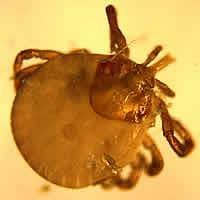
Figure A
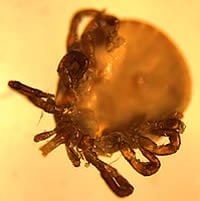
Figure B
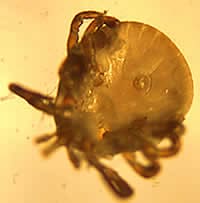
Figure C
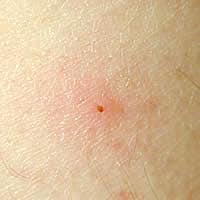
Figure D
Answer to Case #60
The arthropod was a nymphal hard tick (family Ixodidae), which are morphologically different from soft ticks such as Ornithodoros spp. from the family Argasidae). This particular nymphal tick was probably a Lone star tick (Amblyomma americanum), though species identification of nymphal ticks is usually not absolute. Figure E shows a tick still attached to the same person featured in this month's case studies. Diagnostic features of hard ticks include:
- mouth parts that are visible from the dorsal view. Mouth parts of soft ticks are subterminally attached and thus not visible from a dorsal view.
- the presence of a dorsal plate (scutum). This feature is absent in soft ticks.
- sexual dimorphism, meaning that there are visual differences between males and females (e.g., the scutum is larger in males than in females).
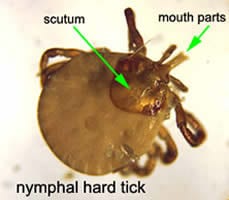
Figure A
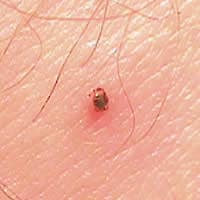
Figure E
Ticks are important arthropod vectors of human disease, second only to mosquitoes. Some of the diseases that can be transmitted by hard ticks are listed below:
- Babesiosis—vector is Ixodes scapularis (black legged tick).
- Lyme Disease—vectors are Ixodes scapularis and I. pacificus.
- Erlichiosis—vector is Amblyomma americanum (Lone star tick).
- Rocky Mountain Spotted Fever—vectors are Dermacentor variablis (American dog tick) and D. andersoni (Rocky Mountain wood tick).
Soft ticks are vectors of relapsing fever, a spirochetal disease. In addition, it is important to be able to distinguish ticks from other arthropods, such as lice or fleas.
More on: Ticks
Images presented in the monthly case studies are from specimens submitted for diagnosis or archiving. On rare occasions, clinical histories given may be partly fictitious.
 ShareCompartir
ShareCompartir


